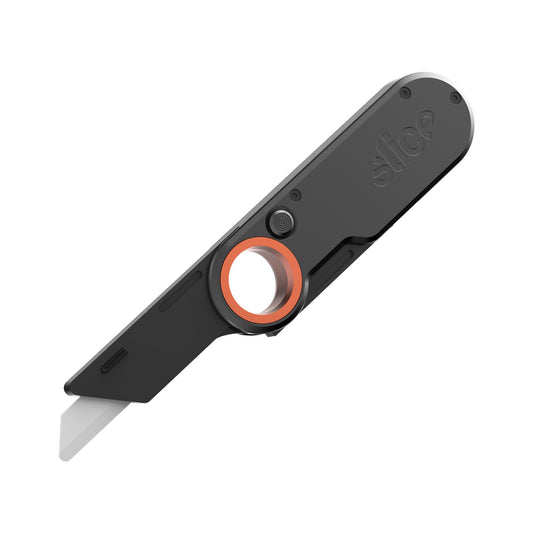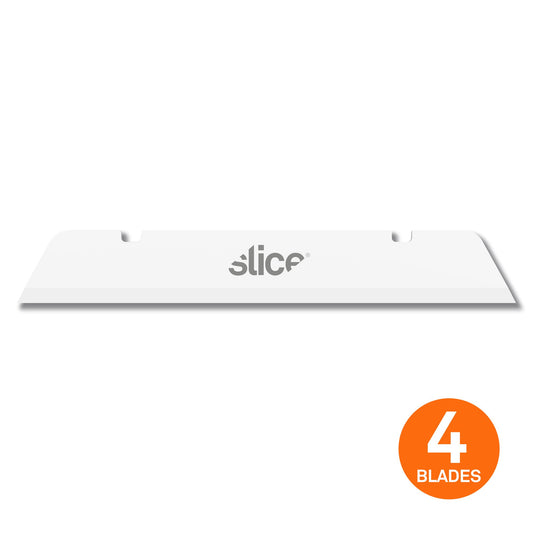How to Cut Ceiling Tile: Safety First
This video shows how to cut ceiling tile safely and easily with the Slice® Manual Industrial Knife.
The steps for how to cut ceiling tile are straightforward. Measure and mark where you want to cut and—using a cutting tool in good working order—make your cut. The one part of the process that almost all instructions overlook is safety.
Safety, especially where cutting tools are concerned, should always be the priority. If your cutting task ends with a trip to the hospital, you’ll have much more to be concerned about than your ability to complete a project. Staying safe is critical to the success of your task.
Any ceiling tile cutter will have a blade, and most blades are dangerously sharp. That is, most blades pose a high risk for lacerations and punctures. Your hands are particularly vulnerable when embarking on a ceiling tile cutting task.
At the least, a cut to your hand will disrupt your work, and it will hurt! If your cut is deep enough, you may have to go to the ER for stitches. A cut that severs connective tissue may require surgery and rehabilitation. Hands are complex; there are numerous small muscles and connective tissues responsible for the fine movements your hands and fingers make. This also make them difficult to fix and heal.
So, while there may be many resources for simple instructions about how to cut ceiling tiles, only those that address safety provide you with the best way to cut ceiling tile.
How to Cut Ceiling Tiles Safely
To make safety your priority, start by setting up your space properly. Clear your work area of anything that may cause a distraction, become a tripping hazard, or get in the way of your cutting motion. Look up, too: falling objects will definitely distract you! Be sure other people and pets are out of harm’s way.
The blade you’re using should be clean and rust free. If you are using a tool with a metal blade, remember that these dull quickly, especially when you’re cutting thick, abrasive materials like ceiling tile. Blades are most dangerous when they are overly sharp—which is how traditional blades come out of the box—and when they’re dull.
Don’t forget your protective gear. Gloves protect your hands from cuts and abrasions: ceiling tile is rough. They’ll serve double duty by protecting the tile from getting fingerprint marks. Make sure your gloves are clean and free of holes, and that they fit well—gloves that are too big or too small may impair your ability to work, which creates its own set of hazards.
Slice®: The Only Safer Blade
Taking these common safety precautions is important, but there is one precaution that gets to the heart of the problem: using a safer blade. It’s the blade that causes lacerations, after all. Most cutting tool manufacturers focus on reducing blade exposure when addressing safety. Slice is the only tool-maker to actually design a safer blade.
Slice blades are 100 percent zirconium oxide, a high-quality engineered ceramic. Slice’s patent-pending blade design is finger-friendly®: it’s safe enough to touch.
The design takes advantage of the hardness of industrial ceramics: Slice blades have been tested to last up to 11 longer than steel blades. This means you won’t need to change the blade as often. Blade changes take time and disrupt workflow. And they’re dangerous: whenever you directly handle a blade, you risk getting cut. Handle blades as infrequently as possible.
Slice: Safer Ceiling Tile Cutter Options
Slice tools are excellent choices in any quest for the best way to cut ceiling tile because they are safer. The Manual Industrial Knife and Auto-Retractable Industrial Knife work well for this task. Both models feature a slider button that the user must engage to expose the blade.
The manual tool provides three blade stops to adjust blade depth. The user must keep the slider engaged on the auto-tractable model to keep the blade exposed. When the user releases the button, the blade immediately retracts safely back into the handle.
Both tools ship with the Rounded-Tip Industrial Blade, and are compatible with the Pointed-Tip Industrial Blades. The tool and blade you choose depends on the level of safety you require and the tasks you will perform.
Slice’s lineup of safety utility knives cut ceiling tile as well:
- Manual Utility Knife
- Auto-Retractable Utility Knife
- Smart-Retracting Utility Knife
- Folding Utility Knife
Beyond cutting ceiling tile, the industrial knives and utility knives make great general use cutting tools. They’ll cut many common materials:
- cardboard
- palette wrap and banding
- paper
- clamshell packaging
- packing tape
- foamcore
The industrial knives are particularly well suited for thick materials like fiberglass insulation, foam, and ceramic fiber blanket. Please visit What You Can Cut With Slice to see additional Slice demonstration videos.
Many cutting tasks, like cutting ceiling tile, don’t require much expertise, instruction, or skill, and there are many tools that could get the job done. But why choose a dangerous tool when there’s a safer option?
Whenever you think about how to cut ceiling tile, always start by addressing safety.





